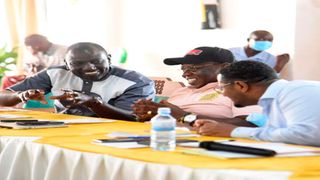
Deputy President William Ruto with Kilifi North MP Owen Baya and former Mombasa Senator Hassan Omar during an Economic Forum for Coast Region Political and Professional Leaders at Sun N Sand Beach Hotel in Kikambala, Kilifi County.
| Kevin Odit | Nation Media GroupPolitics
Premium
William Ruto’s strategy to bag presidency, control Parliament
Deputy President William Ruto is working on a two-pronged strategy to reap maximum benefit from parties affiliated to the United Democratic Alliance (UDA) associated with him.
By embracing the parties without demanding they dissolve to join UDA, and allowing them to field candidates in regions where they are considered strong, Dr Ruto hopes the competition will boost voter turnout that will also be to his advantage as the parties will be rallying behind his presidential candidature.
And this will also boost the chances of his alliance getting as many MPs as possible, a critical factor for any presidential candidate.
An insider in the DP’s camp revealed that whereas they are seeking to build UDA into a single popular national outfit, they will not coerce like-minded parties to merge, suggesting the party has bowed to pressure from affiliates to retain their identities.
Some of the fringe parties either have significant support in their various bases or would attract popular candidates for other seats and would benefit their presidential candidate where UDA might not have had a chance.
The Service Party
Some of the parties that are already working with the DP include The Service Party (TSP) of former Agriculture Cabinet Secretary Mwangi Kiunjuri, Chama Cha Mashinani of ex-Bomet Governor Isaac Ruto, Peoples Democratic Party (PDP) linked to former South Mugirango MP Omingo Magara and Migori Governor Okoth Obado as well as Peoples Empowerment Party (PEP) of Gatundu South MP Moses Kuria.
Others are Green Congress of Kenya led by former Rangwe MP Martin Ogindo as well as Citizen’s Convention Party (CCP) of Kisumu politician Grace Akumu.
These fringe parties often offer alternative vehicles for popular candidates for governor, MP and MCA seats shortchanged by main parties.
“We want to build UDA to be the most popular party in the country but we don’t also want to lose our partners as they are key in certain regions and we hope they will help us gain traction in those areas for the sake of the 2022 elections,” the source said.
The DP, it seems, wants to avoid the hustle of pushing for a merger given most of the affiliate parties instead prefer to have a coalition with UDA.
“I support Ruto, but I will not join UDA because I am in TSP,” Mr Kiunjuri who is said to be angling for a running mate post in the DP camp said recently.
This new turn of events now means that the DP, who was the biggest advocate of merging of parties to form one strong monolith in the run up to the 2017 election, has changed strategy to work with parties with no intention to dissolve their outfits.
Hustler Nation
Already, the feud over the Kiambaa parliamentary by-election where Gatundu South MP Moses Kuria’s PEP was forced to withdraw from the race to back UDA’s John Wanjiku is a reflection of the fights that Dr Ruto will have had to contend with if he takes the Nasa 2017 route instead of the Jubilee 2017 path, that saw the folding of 12 parties to form Jubilee party
UDA secretary general Veronica Maina dismissed fears of divisions in the hustler nation.
“All these sister parties of UDA are very clear on the presidential candidate they are supporting and they also have their own aspirations which is acceptable because we are in a democratic state. PDP and PEP will continue running their agenda, compete with us,” she said in Eldoret when she met 2022 UDA aspirants drawn from Nandi, Uasin Gishu, Elgeyo Marakwet, Trans Nzoia, West Pokot, Turkana and Baringo.
In what suggests the height of the UDA dilemma, Ms Maina said the party had resolved to allow its affiliate parties to field in certain areas where those outfits are strongest—a potential landmine in the upcoming primaries for the 2022 polls.
“We usually have certain arrangements that in certain areas there is a party which is stronger than the other hence will team up and work together to achieve a common agenda of lifting mwananchi to a better economic level,” said Ms Maina, who had guided the Jubilee 2016 merger process when she was the secretary general before shifting alliances.
Yesterday, Ms Maina said UDA had no plans to push for the merger of the parties supporting the DP.
Premature
“UDA will negotiate later because they are our sisters,” Keiyo South MP Daniel Rono added.
Elgeyo Marakwet senator Kipchumba Murkomen and his Murang’a counterpart Irungu Kang’ata said the discussion on whether or not the DP will have those leaders supporting him fold their parties, was premature.
“Our focus now is on building this new party at the moment, but we cannot block anybody from supporting the DP. We are not in a fight. We may convince them at a later date to join UDA, or not, but we will try as much as possible to get people to support us and the DP’s presidential bid,” Mr Murkomen said.
Mr Kang’ata said there was nothing out of the ordinary in the party leaders retaining their outfits even as they backed the DP.
“It is illogical of any person to think that there will be only one party affiliated to Ruto in Mt Kenya region. It didn’t work in 2002 and 2007 under Kibaki and 2013 / 2017 under Uhuru.
We shall only strive to make UDA the party and others (PEP and TSP, among others) our sister parties helping us for the larger cause. Kuria and Kiunjuri parties will exist in the Ruto political wing,” Mr Kang’ata said.
-Additional reporting by Onyango K’Onyango






